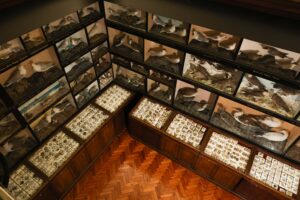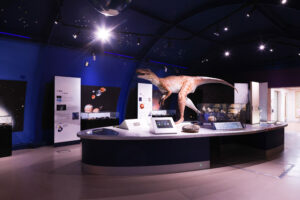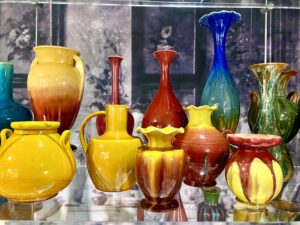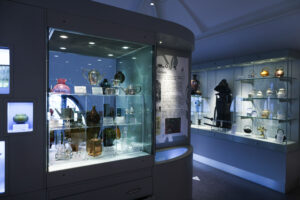Galleries
Discover the story of Middlesbrough through exciting displays of local history, archaeology, natural sciences and the world’s greatest collection of Linthorpe Art Pottery.

Town in Time
Stroll through two galleries dedicated to the area’s local history, with an array of objects that tell the story of the town and its people. The urban origins of Middlesbrough may have been as a Victorian new town but people have lived in this area for thousands of years, stretching back to the late Stone Age.
Explore the prehistoric technologies that created a dugout canoe found in the banks of the River Tees and the important role played by that waterway in the development of the town.
See the carved stones and Norman font that are all that remains of the 7th century Middlesbrough Priory and discover items from Middlesbrough’s more recent religious past with the Bishop’s Chair Middlesbrough’s first Roman Catholic cathedral, and stained-glass windows from the Central Methodist Church.
The town’s industrial heritage is beautifully illustrated on a large silk banner on display which was painted in 1920 for the Iron and Steel Trades Confederation.
The story of the daily lives of the people of Middlesbrough continues in the reconstructed shopping street which features a school room, pawnbrokers, cinema and pub amongst the shop displays that reconnect you to the past.
Peek through a kitchen window to see how domestic technology has advanced from the days of cast iron cooking ranges and cumbersome mangles. And don’t forget to say hello to the back yard pig who was fed on all the leftover scraps!

The Nelson Gallery
A 19th century collection of mounted birds and eggs amassed by renowned local ornithologist Thomas Hudson Nelson who wrote the first descriptive works on ‘The Birds of Yorkshire’. This collection came into the museum as a bequest in 1918 and has been maintained in its original Edwardian setting, serving as a reminder of what the Dorman Museum was like in its early days.
Specimens on display are from many of the classic bird sites in the UK. Nelson’s enormous collection of guillemot eggs was amassed through liaisons with egg collecting groups established at Bempton cliffs near Flamborough on the North Yorkshire coast.
Over 100 mounted bird specimens are on display in the gallery. Most were mounted by a taxidermist called Mr. Mussel, who had a shop in Middlesbrough and many cases have colourful landscape backgrounds painted by Nelson and his friends, including the well-known Lancastrian artist William Woodhouse.

Earth in Space
This exciting, interactive gallery tells the story of how our planet was created and how it continues to be affected by cosmic, geological and biological forces.
Visually stunning, the gallery features a full size dinosaur model, an evolution of human skulls display, a sparkling walkthrough mineral mine and large objects to touch.
We explore the themes of the origin of the universe, the formation of planet Earth, comets, meteorites, rocks, geology, minerals, evolution and extinction.
Many of the museum’s most attractive and scientifically important fossils, rocks and minerals are on display including specimens from both local areas and from around the world. The gallery shows one of the largest Ichthyosaur fossil skulls found in the UK and a set of meteorite slices including a piece of rock thought to come from Mars.
The story of the Middlesbrough meteorite is also told with a cast of the actual hole it made when it fell to earth in March 1881.

Linthorpe Art Pottery
Follow the story of how a small pottery that began operating in late 19th century in Middlesbrough and produced some of the most innovative and exciting art pottery of the Victorian era. Established in 1879 by John Harrison, a local entrepreneur, and Christopher Dresser, one of the leading designers of his day. Linthorpe Art Pottery went on to produce over 2,000 different shapes of ceramic ware decorated with vibrant coloured glazes.
Linthorpe Pottery was only in production for ten years but became well-known and respected around the world and the wares are still popular and highly collectable today. Its distinctive mark has made it easily recognizable.
With John Harrison’s untimely death in 1889 the Linthorpe Pottery was forced to close and the buildings and contents were sold. Many of the moulds were bought by other pottery manufacturers allowing Linthorpe’s legacy to continue with its shapes and forms still being casted into the 20th century.
The gallery explains how the pottery came about, who the people behind it were, why they chose a site in Middlesbrough, where the ideas and inspiration sprang from for the radical shapes produced and takes a closer look at the work of individual pottery artists. The Dorman Museum's collection of Linthorpe Art Pottery is the largest in public ownership and the majority of those pieces are on display.

Christopher Dresser
In 2013, with assistance from the Heritage Lottery Fund, Art Fund and the V&A Purchase Grant Fund, the Dorman Museum was able to purchase a significant private collection of over 200 works by the renowned Victorian designer Christopher Dresser and an extensive archive of research material. It also enabled the museum to create a dedicated gallery to showcase the prestigious collection that demonstrates Dresser’s skill in being able to produce innovative and timeless designs.
Discover how Dresser was inspired by his botanical studies, artefacts from ancient cultures and traditional craftworks from around the world, in particular from Japan which he greatly admired and influenced his most radical designs.
During his lifetime Christopher Dresser was a household name, known for his exciting designs for furniture, metalwork, ceramics, glass, textiles and wallpaper which are all represented in this gallery. He worked for many major Victorian manufacturers and today is revered as the “Father of Industrial Design”. Locally Dresser is associated with the Linthorpe Art Pottery where he acted as Art Advisor and Art Superintendent and these connections with Middlesbrough are an important part of the town’s heritage.